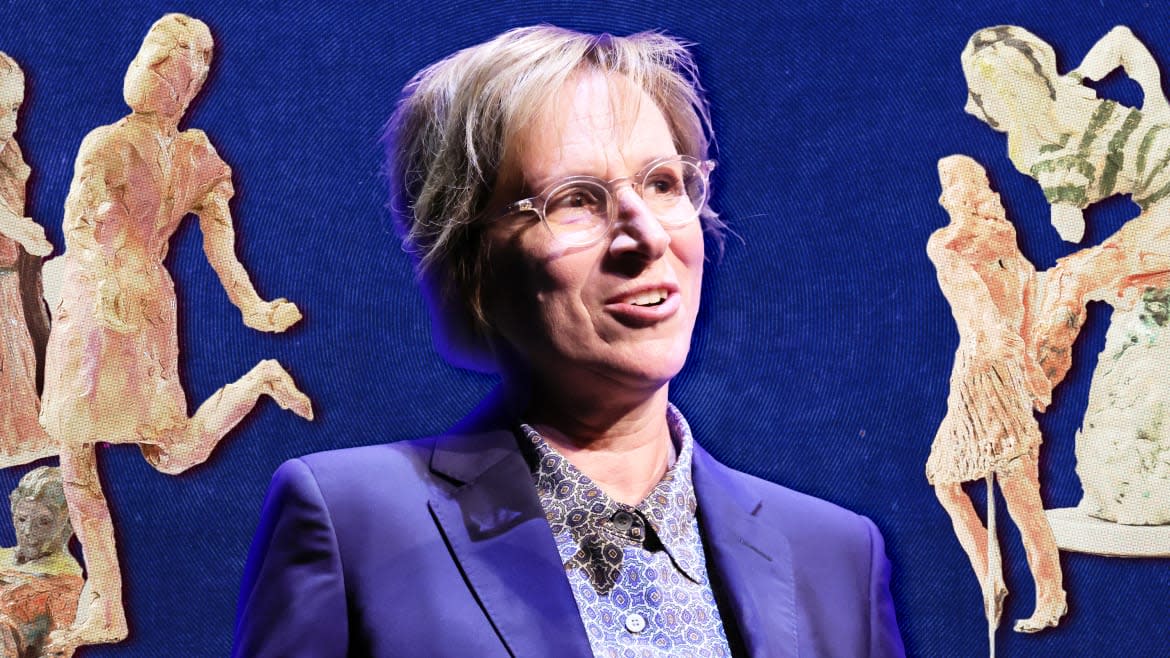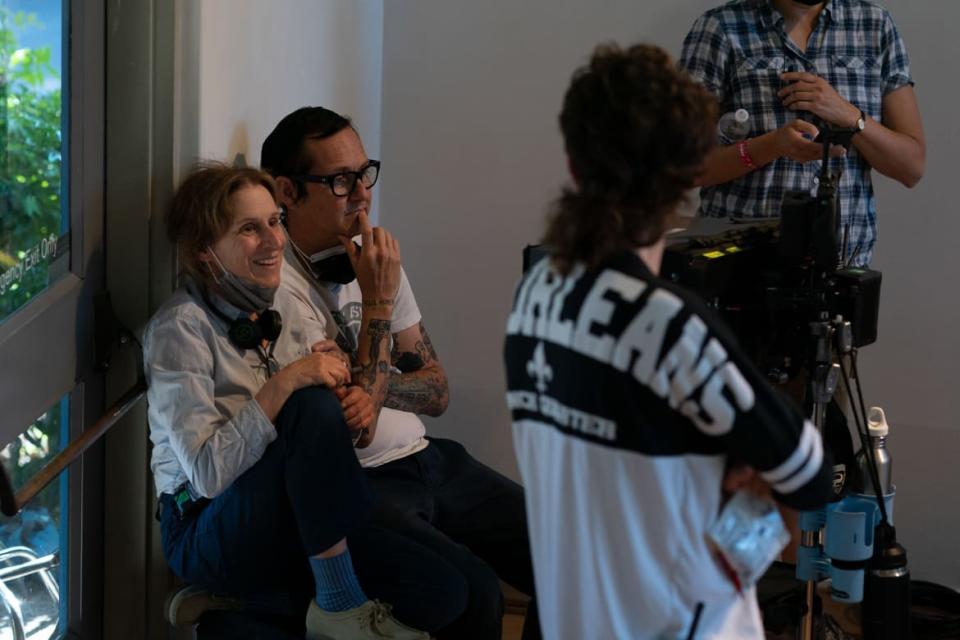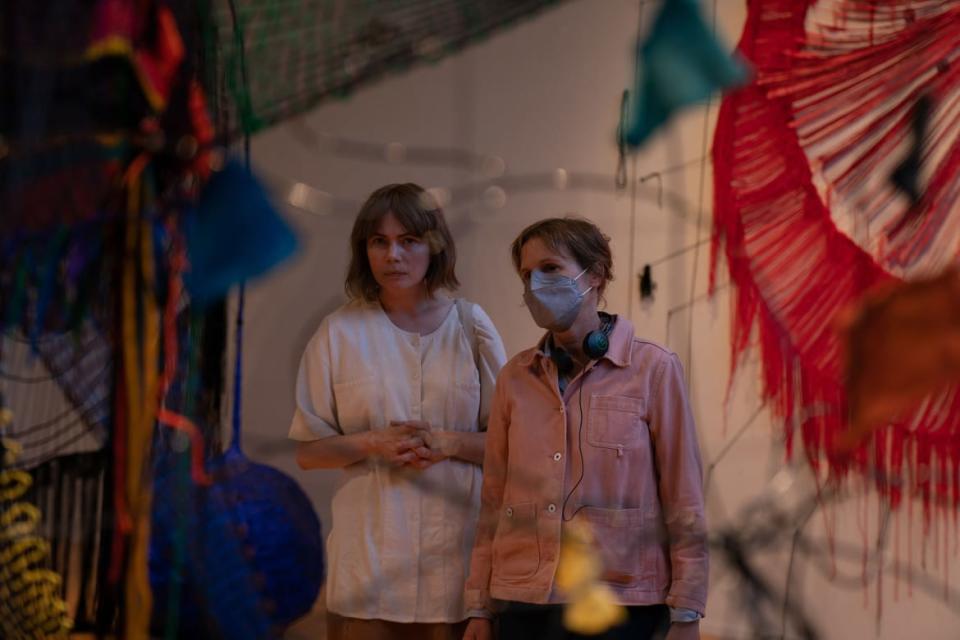Kelly Reichardt’s Latest Film Is Also Her Most Star-Studded—Not That She Cares

- Oops!Something went wrong.Please try again later.
- Oops!Something went wrong.Please try again later.
- Oops!Something went wrong.Please try again later.
Showing Up is acclaimed director Kelly Reichardt’s eighth film, and it may be her best yet. The story of a quiet, sensitive artist as she overcomes personal obstacles as she prepares for her first small show, Reichardt crafted a film that is deeply affecting and—most surprisingly—very funny.
Michelle Williams plays bedraggled sculptor Lizzy, in her fourth collaboration with the director. When she’s not struggling to get her abstract art together for the show she is anxiously prepping, she is wasting away in the back office of a local arts school. Reichardt’s so-called “day job” is working as an artist-in-residence at New York’s Bard College, a small liberal campus that resembles the one where much of Showing Up takes place. In that way, this feels more personal than some of the director’s past work. (Those films include 2020’s First Cow and 2008’s Wendy and Lucy, Reichardt’s first project with Williams.)
In ‘Showing Up,’ Michelle Williams Brilliantly Taps Into an Artist’s Inner Hell
Add in the fact that this is an artist making a movie about making art, and Showing Up may sound like a self-reflexive intellectual exercise. But it’s much less pretentious than that; in fact, it’s gloriously unpretentious. It’s an almost whimsical feature that leaves us rooting for Lizzy in all of her mini-quests: from wishing that Jo, her landlord/fellow artist (Hong Chau), would turn Lizzy’s hot water back to making sure her troubled brother Sean (John Magaro) gets to her art show okay.
The Daily Beast’s Obsessed talked with Reichardt ahead of Showing Up’s April 7 theatrical release. We talked about her unique take on the worlds of art and academics, the good timing of having three recent Oscar nominees in the cast of your new film, and whether the polarizing “slow cinema” movement is finally winning over the mainstream viewer.
You’ve taught film at Bard College since 2006. As someone who works in academia, what drew you to setting a story in that world for the first time?
I don’t think it’s so much [about] academia because it’s an art school. I’m making that distinction from a liberal arts school. [But] it didn’t start out with that. It started out with the idea of how to survive the day-to-day life of a working artist, who has to balance a job and family and all the things in life.
[We filmed at] the Oregon College of Arts and Craft, which was an institution in the Pacific Northwest that closed down in 2018. But it was a 100-year-old school and a really important place in the pottery and ceramic scene in the ’60s and ’70s, right up until the time it closed. It was a really important place for a lot of people. The school was empty, so we incorporated it.
It was a time where my teaching life and filmmaking life came together, which was cool. Even Ben Coonley, who I teach with at Bard, came and set up his dome and projections and worked with the art department, making up that whole classroom. The place where the faculty room is and the little office— in my teaching experience, that’s where a lot of the action is, around the lounge. That all made its way into the film.

Why was it important that Lizzy, our main character, not be part of her fellow artists as a faculty member, but stuck working in the administration office?
It separates her [from them], because she’s not getting noticed for what she wants to be doing. She’s making flyers for other people’s shows that they’re gonna have at the school. Her day job is separate from making art.
She’s still turning up at her table every day to work, whether that’s for a show or for the compulsion of wanting to make stuff. It’s for its own sake a lot of the time. But she does have a show coming up, and she is trying to balance it, [while] the people around her are being acknowledged as artists, and she’s got other kinds of work to do.
Something that I like about this film is that the art world here feels more unglamorous than we’re used to seeing. Despite Lizzy and her landlord Jo both chasing public attention and achievement, Lizzy’s aspirations feel much more local. What interested you about exploring this smaller-stakes version of that quest for success?
Whatever the stakes are in your life are your stakes. I mean, most of the people in the world making stuff aren’t having shows in Chelsea. They’re having shows in their neighborhood with their community or in their colleges.
When you’re compelled to make stuff, it’s sort of like eating. You gotta work every day. Even if your audience is the same people that have been seeing your work for 20 years, that’s who you’re making work for… There’s the audience of yourself that you want your work to live up to, where you know you want it to be whatever you want it to be—to have beauty or to resonate in some way. So these two women in the film, they recognize that their work’s really different. But I think they admire each other and have a respect for each other’s art.
The timing of the film’s release comes one month after the Oscars, where three of your stars were nominated for awards: Michelle Williams (The Fabelmans), Hong Chau (The Whale), and Judd Hirsch (The Fabelmans). André 3000 of Outkast also plays a faculty member. Do you ever think about whether your bigger-name actors will distract audiences from the story?
This is America, and the way you get films financed in America is largely because of the presence of the people in your movie. I’m lucky enough to work with these actors. They’re super talented and good people to work with. [But this is] not England or something—a Mike Leigh film’s not gonna get made in America.
A lot of the people I work with, I’ve worked with over and over again, and I’m happy for them, and I’m glad I don’t have to live through all that. I’m getting a free ride, because I don’t have to live through all that Oscar stuff, and somehow I can just be on the coattails of whatever good fortune my actors have. [But] I can’t think about all that outside stuff. That’s why I teach, and I make films with a small community of people.
I know what you mean, when someone you don’t recognize is just gonna be the person you know. It’s easier for them to be the character, because you don’t associate them with anything else. But that’s not really how films get made in America.

All of the actors’ characters feel very lived-in—particularly Judd Hirsch as Lizzy’s chaotic artist father. He has a big hand in establishing the film’s tone as more comedic than your usual work. How much did you lean on him to cultivate that sense of humor?
We knew we were making something that had humor in it, and that was fun to do. Sometimes it’s in the writing, and sometimes it’s in the performance or in the delivery. Sometimes it’s in the cut. It’s not in all places at once. And I still wanted to make a film where things were really at stake.
But Judd can make things funny in different ways, depending on what take he’s on. I was really impressed with, um, how many different ways he could do a scene, where he could make something funny and change those spots of where [the jokes are]. That was super interesting because there’s just so many different ways that things could be played.
Judd is kind of playing in his own orbit, in his own space, so it makes what he’s doing a little different. It was really fun in the editing room, just getting to choose which version to use.
Yeah, I can imagine how funny it was to work on that one scene, for instance, where Lizzy goes to visit her dad at his house. He just has that random shoeless couple crashing on the couch.
That was a good one. I mean, Amanda Plummer, oh my God. And Matt Malloy—those guys are really good together. You could just film those guys all day long. Even when Amanda Plummer’s in the background, she’s up to so many things. It’s really, really fun.
Does ‘Jeanne Dielman’ Deserve to Be the New ‘Greatest Movie of All Time’?
Yeah, that whole subplot was so fun—every time that pair appeared on scene, everyone in the theater would just start laughing. It was like, “What is going on in this part of the movie? What is up in that house?”
I just wanted to sneak in one last question. Your work is often considered part of the “slow cinema” movement. That term is controversial, but this year’s Sight and Sound poll named Chantal Akerman’s Jeanne Dielman, 23 quai du Commerce, 1080 Bruxelles—a big hallmark of that kind of film—the greatest movie of all time. Do you think the general impression of slower-paced films has changed, since the beginning of your career?
Jeanne Dielman’s an important film for a lot of people, and myself included… Obviously the world’s faster, faster, faster, faster. But pacing works differently in different films. It’s only [compared to] what it’s next to, right?… Nothing really stands alone. [Calling something slow- or fast-paced is] like you’re flicking through a book.
But some things that we’re calling slow cinema, what we’re really talking about is a 30-second shot, which is, to my mind, not that slow. It’s just that the world is so sped-up.
Get the Daily Beast's biggest scoops and scandals delivered right to your inbox. Sign up now.
Stay informed and gain unlimited access to the Daily Beast's unmatched reporting. Subscribe now.

